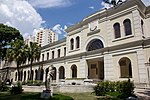Estádio Rua Javari

Estádio Conde Rodolfo Crespi, usually known as Estádio Rua Javari, is a multi-use stadium located in São Paulo's Mooca neighborhood, Brazil. It is used mostly for football matches and hosts the home games of Clube Atlético Juventus, which is also the stadium's owner, and hosted the games of Pão de Açúcar Esporte Clube. The stadium has a maximum capacity of 4,000 people, and was built in 1929. Estádio Rua Javari is named after Count Rodolfo Crespi, who was Juventus' first president and helped the stadium construction. The stadium's nickname, Rua Javari, is the name of the street where it is located in. As it has no artificial lightning, matches are not played after dusk. Clube Atlético Juventus usually schedules its home games to start at 3:00PM (4:00PM when DST).
Excerpt from the Wikipedia article Estádio Rua Javari (License: CC BY-SA 3.0, Authors, Images).Estádio Rua Javari
Rua Javari, São Paulo Mooca
Geographical coordinates (GPS) Address Phone number Website External links Nearby Places Show on map
Geographical coordinates (GPS)
| Latitude | Longitude |
|---|---|
| N -23.553333333333 ° | E -46.604444444444 ° |
Address
Estádio Conde Rodolfo Crespi (Estádio da Rua Javari)
Rua Javari
03112-130 São Paulo, Mooca
São Paulo, Brazil
Open on Google Maps









